Commonly referred to as Angel’s Trumpet, Angel Star, Tree Datura, or Trumpet of Death, Brugmansia is a genus that contains exactly seven species of flowering plants. These beauties belong to the Solanaceae family. You can find them growing natively in several tropical regions of South America, from northern Chile to Venezuela, and also south-eastern Brazil.
Specialists have divided Brugmansia species into two genetically isolated natural groups. The Brugmansia section, which is the warm-growing group, contains species like Aurea, Versicolor, Sauveolens, and Insignis. Meanwhile, the Sphaerocarpium section contains species that grow in cold environments including Arborea, Vulcanicola, and Sanguinea.
At the moment, Angel’s Trumpet plants only exist in cultivation, without any specimens growing in the wild. Although they are pretty popular ornamental plants and still exist outside their native habitat as new species, botanists consider them “Extinct in the Wild”. They believe that the main reason behind their extinction in the wild is the disappearance of animals that dispersed their seeds in the past.
Thankfully, humans viewed these plants as truly beautiful and ensured the genus’s continued survival. Most gardeners that grow Angel’s Trumpet plants value them for their ornamental properties. However, these plants also have other interesting uses worldwide.
Angel’s Trumpet plants play a role in modern medicine, as they contain some alkaloids that have spasmolytic, anesthetic, anti-asthmatic, and narcotic properties. Moreover, traditional South Americans used Brugmansia plants in the preparation of tinctures with anti-inflammatory properties. They used these tinctures to treat many afflictions including arthritis, dermatitis, infections, headaches.
Read on to learn more about growing, watering, and propagating Brugmansia.
About Angel’s Trumpet
- In the Northern Peruvian Andes, local shamans used Brugmansia plants in rituals of black magic, initiation, and divination.
- In Peru and Colombia, modern shamans use certain types of Brugmansia genus in some ayahuasca brews. The hallucinogenic effects are usually described as “terrifying rather than pleasurable”.
- Brugmansia houseplants make great companions to other ornamental plants, such as Euphorbia Cotinifolia, Physocarpus ‘Summer Wine’, or Hibiscus Acetosella.
- Most Angel’s Trumpet plants are fragrant, dispersing their scent in the evenings to attract pollinators like moths. Interestingly enough, one species that lacks scent (B. Sanguinea) is highly attractive to hummingbirds.
- These plants interact with various species of animals pretty often. One curious example involves the Placidula Euryanassa butterflies that use B. Suaveolens as one of their main source of larval foods.
- Brugmansia plants are tropical and they do well in lots of warmth and humidity. They are not drought-tolerant and over-watering can have a negative effect on them.
- Although Brugmansia plants do not require pruning, it’s best to trim them during the fall to induce constant flowering. You can also cut off older stems and branches to encourage new growth.
- Angel’s Trumpet plants are one of the most toxic species of ornamental houseplants. They contain a type of tropane alkaloids that can also be found in the well-known Deadly Nightshade.
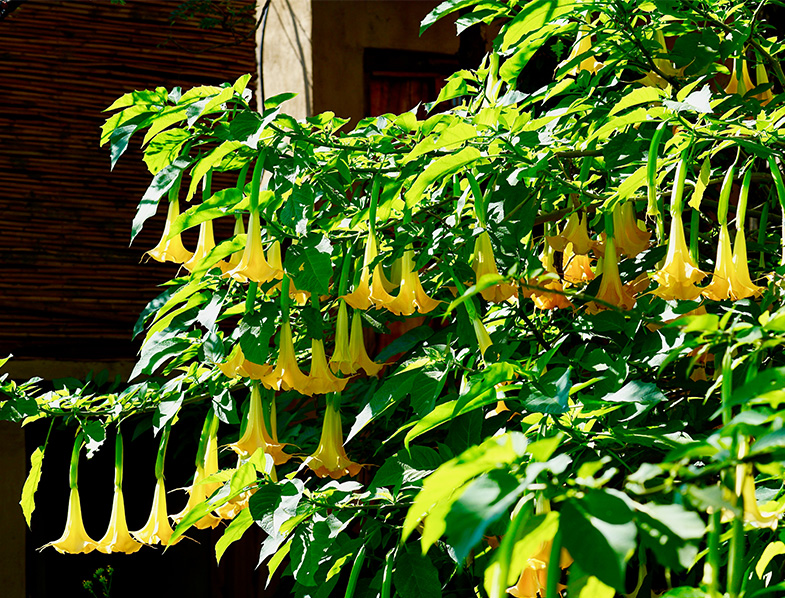
Angel’s Trumpet Features: An Overview
- Brugmansia species are very tall small trees or shrubs that can reach from 10 to 36 feet (3-11 m) in height and 10 to 15 feet (3-5 m) in width.
- The trunks of these plants are somehow semi-woody and often contain many branches. The leaves grow alternately arranged on green and wood-like stems.
- The foliage is generally large, with leaves that measure between 4 and 12 inches (10-30 cm) in length and 2 to 7 inches (4-18) in diameter.
- Their leaves are bright to dark green and come along with coarsely toothed or entire margins. They are pretty soft and often covered with fine hairs.
- During their blooming period, from spring to late autumn, Brugmansia plants produce flowers sporadically. The heaviest flowering occurs in fall, but they can also bloom year-round when grown in warmer climates.
- The alluring blooms are the main attraction of these plants and what gives them the ‘Angel’s Trumpet’ name. Most species exhibit a strong and pleasing fragrance that can be noticed better in the evening.
- Brugmansia bloomings are quite large, pendulous, and present a shape that resembles trumpets. They usually grow about 6 to 20 inches (14-50 cm) in length and 4 to 14 inches (10-35 cm) in diameter when opening.
- Depending on the species, their flowers can appear in various shades of red, orange, yellow, green, pink, and even white. Most specimens may come tinged with an ombre effect and can present more than two colors at once.
- Angel’s Trumpet plants produce slightly spiny, oval, and green fruits. They contain many seeds that are highly poisonous but can be used easily in propagation.
Growing Angel’s Trumpet
We know, Angel’s Trumpet plants are a bit fussy when it comes to touching them, but with time they can become a friendly companion. Although every part of these plants is toxic, you will have nothing to worry about as long as you are cautious and wear protective gloves. Once you realize how simple is to grow and care for these beauties, it will be hard to resist them!
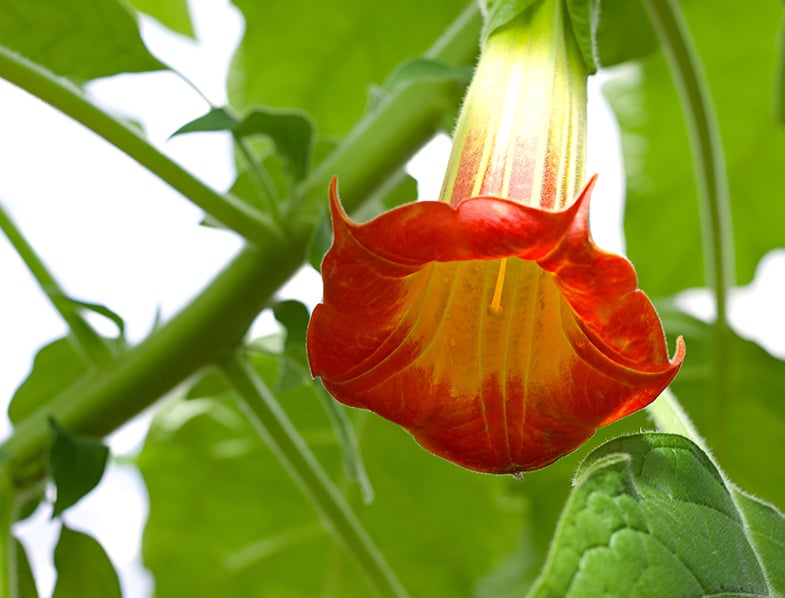
Light-wise, Angel’s Trumpet has different preferences depending on the area you grow them in. If you live in a region with warm climates, your plant will grow best in a location where it can receive plenty of morning sunlight and some shade in the afternoon. In cooler zones, this plant can survive just fine under full sunlight exposure all day.
In terms of temperatures, Brugmansia species can withstand moderate to warm conditions. In autumn, when the temperatures start to get cooler, it is best to bring your outdoor-grown plants to a dark, frost-free location. Once the spring comes with temperatures above 32 °F (0 °C), you can move your plant outside and repot it.
Planting Angel’s Trumpet
Angel’s Trumpet plants will show nice growth if you plant them in acidic soil, but they can also tolerate alkaline soils. If you want to grow these plants in pots, look for commercial potting mixes designed for camellias and azaleas.
Like most species that exhibit spectacular flowers, you’ll have to fertilize Brugmansia plants pretty often. Feed your younger plants with a water-soluble fertilizer at least once a week, especially during their flowering season. When mature and larger, your plants will require fertilizing less often, at about two or three times a week. The ideal fertilizers for Brugmansia plants are bloom-boosting without slow-release formulas, such as 15-30-15 or 10-50-10.
Angel’s Trumpet grows at a pretty fast pace and needs repotting regularly to maintain healthy growth. If you notice that your plant starts to outgrow its container, transplant it in one that is one size larger filled with fresh potting mix. The final container should measure about 16 inches (40 cm) in height and 18 inches (46 cm) in diameter.
The most common pests that can infest your Angel’s Trumpet include whiteflies, cabbage worms, aphids, and spider mites. You can treat the infested parts with a cotton pad dipped in rubbing alcohol. If this method is not enough, treat your plant using neem oil, insecticides, or suitable pesticides.
- Grow as a container plant and bring in for protection in colder climates. The effort is well worth while. Flowers profusely most of the year. Grow in sunlight or part shade.
- This versatile plant is perfect for small gardens as well as potted deck plantings and tropical container specimen plants.
- Perfect for those smaller garden areas or large landscapes.
- Feature. Brugmansia is an exotic, small tropical tree, also commonly called angel’s trumpet, that produces dramatic, pendant, trumpet-shaped, fragrant flowers. Hummingbirds are also drawn to the plant's flowers and fragrance.
- Mature size. Pink Brugmansia is a beautiful Perennial shrub grown in USDA Zones 9 - 11 reaching 6 to 35 ft. in height, with a width of 3 to 10 ft.
- Easy to grow. Brugmansias is easy to grow, eye-catching and fast-growing. With a little bit of patience and the proper care, you can enjoy these beautiful flowers in garden for many years to come.
- Sow. Sow seeds on the soil surface. Cover with about a quarter to one-half inch of soil. Keep the soil warm and moist. Seedlings emerge in two weeks to several months.
- Use. Brugmansias are tender plants that can be grown indoors all year round, or outside from late spring to autumn. They can be grown as a focal point in a border, but are best grown in pots on the patio – somewhere sheltered, where you can enjoy the evening scent.
Last update on 2024-09-25 / Affiliate links / Images from Amazon Product Advertising API
Watering Angel’s Trumpet
Like all tropical species, Angel’s Trumpet is a thirsty plant that requires watering quite often. This plant is not drought-tolerant, so you should provide it with plenty of water every time it demands. It is also susceptible to root rot, you can avoid over-watering if you use a ‘soak and dry’ technique.
Make sure you always check the soil in-between the waterings and water your Angel’s Trumpet plants only when the soil feels dry to the touch. As long as they are not wilting and the soil seems moist, your plants are doing just fine and do not need additional moisture. If you grow these plants in a container, provide them with excellent drainage, as they do not appreciate waterlogging or soggy conditions.
Propagating Angel’s Trumpet
With their alluring appearance and gorgeous, fragrant flowers, it will be a shame not to propagate Angel’s Trumpet plants. Yes, they can reach outstanding sizes and space might be a problem, but you can always gift one of these babies to your family or friends. You can propagate Angel’s Trumpet fast and easily through seeds or cuttings. Just make sure you do not forget about those protective gloves we have been talked about earlier!
You can collect the seeds from the plant’s fruits and sow them in fresh soil. Fill a pot or bed with a suitable potting mix and place the seeds just above the substrate. Place the container in a warm and shaded location and provide the seeds with regular watering to maintain the soil moist. Usually, the seeds will germinate in a month or so. Once the seedlings have reached about 2-3 inches (5-8 cm), you can transplant them to their individual pots.
If you want to propagate your Angel’s Trumpet by cuttings, you must use healthy stems. Cut about 2 inches (5 cm) from the stem using a sharp and clean knife and remove any extra leaves from the bottom half. The cuttings will root faster if you plant them in suitable potting soil and keep it constantly damp. Once you place them in a shaded area, the cuttings will develop a strong root system after a few weeks.
In Conclusion
Without a doubt, Angel’s Trumpet plants are the missing piece of your gardening puzzle! With their mesmerizing look, these plants can be the center of attraction in every garden, room, or even near door entrances. If you provide them with environmental conditions that are on their taste, these beauties will be your elegant companion for a long time!
If you are growing Angel’s Trumpet, share your experience with us in the comments below!
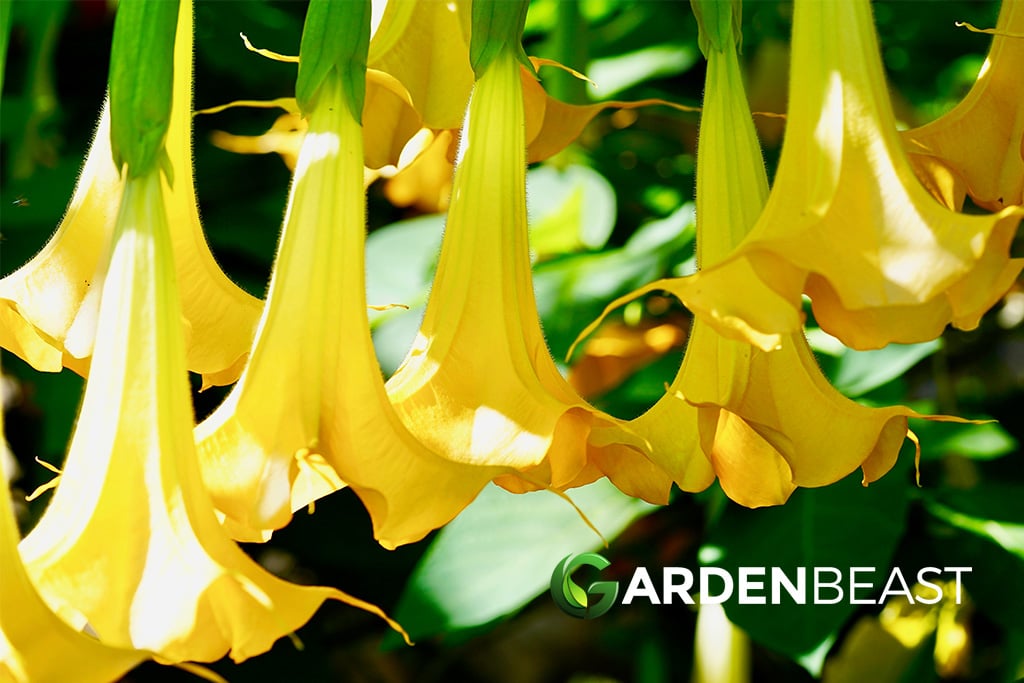
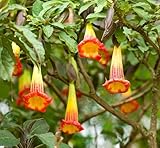

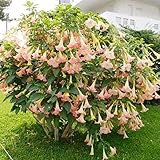
1 Comment
Leaves turned to Black what to do